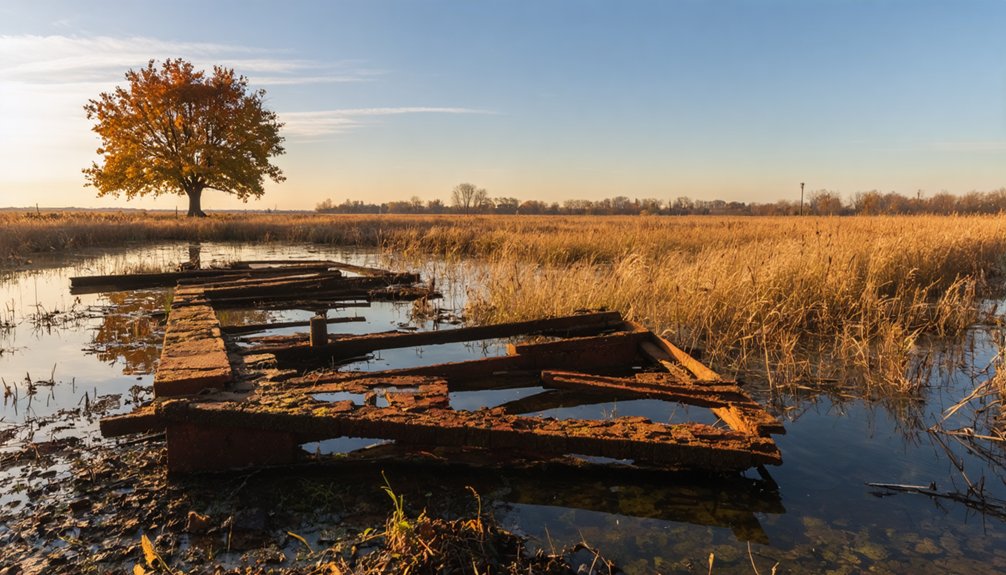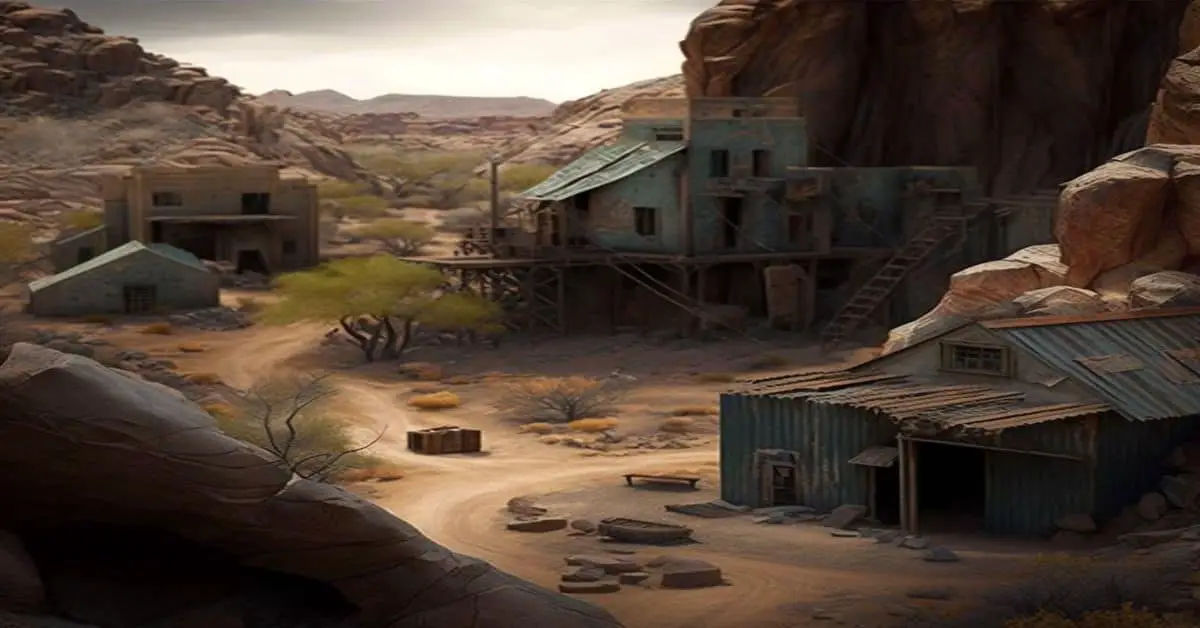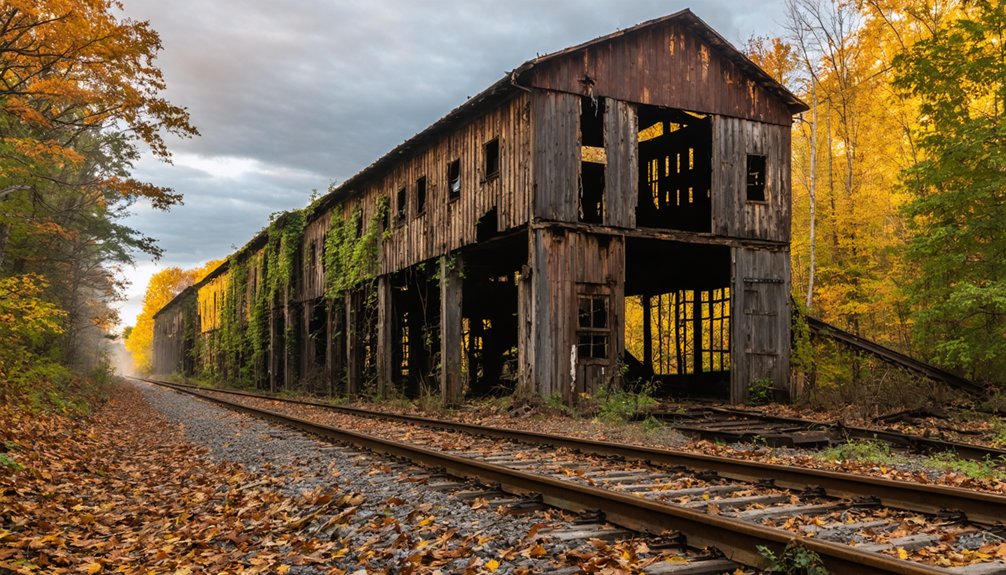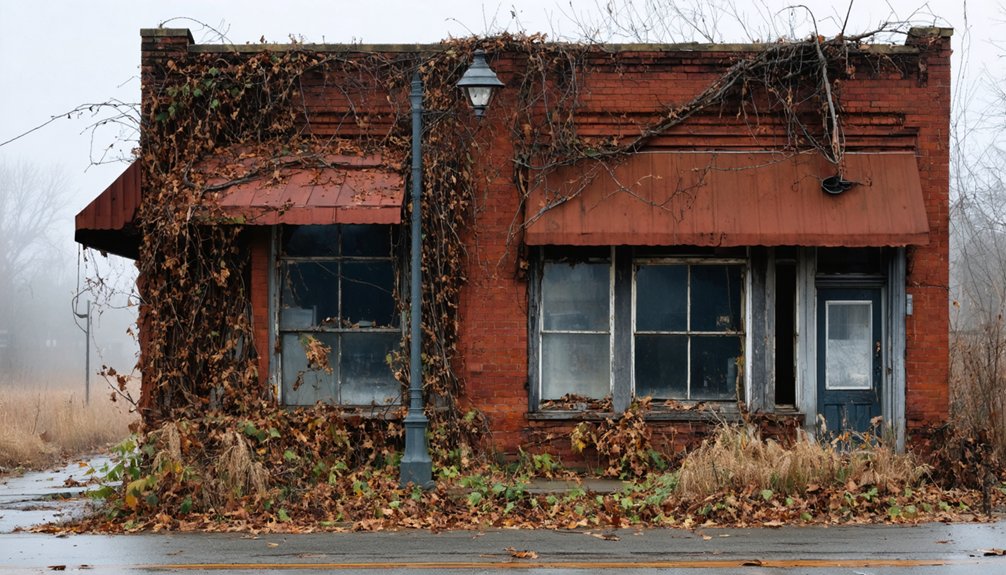You’ll find Monument City, Indiana submerged beneath Salamonie Lake in Huntington County. The town began in 1869 with a $500 fund to build a marble obelisk honoring 27 Civil War soldiers. By 1874, Jacob Leedy and James Pilcher established the settlement, which grew to include 20 homes, a school, and a Wesleyan Church. In 1965, the U.S. Army Corps of Engineers’ flood control project submerged the town, though during droughts, fascinating remnants emerge from the depths.
Key Takeaways
- Monument City, Indiana was established in 1874 near the Salamonie River and named after a marble obelisk honoring Civil War soldiers.
- The town had approximately 30 residents, a K-12 school, Wesleyan Church, and basic businesses before its submersion.
- In 1965, Monument City was permanently submerged due to the construction of Salamonie Reservoir for flood control purposes.
- The town’s cemetery was relocated along Highway 800 West, preserving 1,200 graves from the original settlement.
- Remnants of Monument City become visible during droughts, with building foundations and road fragments appearing beneath Salamonie Lake.
The Birth of a Memorial Town
In 1869, residents of Polk Township pooled $500 to erect a marble obelisk honoring 27 local Civil War soldiers who made the ultimate sacrifice.
You’ll find this monument was strategically placed at a crossroads near the Salamonie River, where roads 800 W and 350 S would later intersect. A spread-winged eagle crowned the memorial, watching over the inscribed names of the fallen.
The monument’s memorial significance proved so powerful that it inspired the founding of an entire town.
Such was the monument’s impact that an entire community took root around this tribute to fallen heroes.
In 1874, Jacob Leedy and James Pilcher platted Monument City around this sacred marker, building upon the pioneering spirit of early settlers like Jacob Fisher, who’d arrived in 1836.
The town’s very name reflected its deep community identity, forever linking the settlement to those who gave their lives for freedom.
A sawmill and blacksmith shop were among the first businesses to open, establishing Monument City as a growing frontier community.
The town grew to include a school and church that would become cherished landmarks for generations of residents.
Life in Monument City Before the Flood
Before its watery demise, Monument City thrived as a close-knit rural community of roughly 30 residents spread across 20 homes near the banks of the Salamonie River.
You’d find daily life centered around agricultural practices, with farmers tending their fields and gathering at the general store’s porch after chores.
The town’s modest infrastructure included a K-12 schoolhouse that served 125 students at its peak, a Wesleyan Church, and essential businesses like the Weeks & Syler sawmill and William Armstrong’s blacksmith shop.
Community gatherings typically revolved around church services, school events, and informal meetups at the local store.
The Civil War monument and cemetery served as important cultural landmarks, while the fertile river valley supported the farming-focused economy that sustained the town until its evacuation in 1965.
During severe droughts, particularly in 2012, visitors can observe the foundations of these original buildings emerging from the Salamonie Reservoir’s receding waters.
The Salamonie Reservoir Project
The U.S. Army Corps of Engineers constructed the Salamonie Reservoir in 1966, creating a massive flood management project that forever changed the landscape of Huntington and Wabash Counties, Indiana.
You’ll find an impressive earthen and rockfill dam stretching 6,100 feet long and rising 133 feet high, impounding what’s now Salamonie Lake.
The reservoir regulations established joint oversight between the Corps and Indiana DNR, encompassing 12,000 acres of land and water.
The project created a 4.5-square-mile lake with a maximum storage capacity of 263,600 acre-feet, designed primarily for flood control and storm water management.
Popular fish species like white crappie and walleye can be found throughout the waters of the reservoir.
Today, you’re free to enjoy multiple recreational activities around the reservoir, including boating, swimming, and fishing, while protected areas like Salamonie River State Forest and Lost Bridge State Recreation Area offer additional outdoor opportunities.
Preserving Monument City’s Legacy
While Monument City now lies beneath Salamonie Lake‘s waters, dedicated preservation efforts assure its legacy endures through multiple initiatives.
You’ll find the relocated cemetery along Highway 800 West, where the original 1869 Civil War monument honoring 27 local soldiers now stands at its entrance. About 1,200 graves were carefully moved here before the flooding, preserving crucial genealogical records for future generations.
Through community engagement, you can join DNR-guided tours to view exposed remnants during low water periods. The town, which was founded to honor Civil War soldiers from Polk Township, represents an important piece of Indiana’s military heritage.
Similar to other preservation projects, the site may require Legacy Grant funding to maintain its historical elements for future generations. The nearby Interpretive Center at Lost Bridge West Recreation Area showcases the town’s history through photos and exhibits. Indiana’s robust historical preservation programs, supported by significant grant funding, assure Monument City’s story remains alive through educational programs and protected historic sites.
Underwater Remnants and Modern Discovery
Hidden beneath Salamonie Reservoir‘s waters since 1965, Monument City’s remnants lie submerged under roughly 13 feet of water across 950 acres of Indiana landscape.
You’ll find these underwater archeology sites disclosed during significant droughts, revealing scattered bricks, house foundations, and fragments of gravel roads from the once-thriving town.
The site garnered massive community engagement in 2012 when severe drought conditions revealed the town’s layout. Nearly 1,000 visitors attended the first DNR-supervised tour to explore the exposed foundations.
While initial access was unrestricted, concerns about artifact preservation led officials to implement controlled visits.
Though media reports exaggerated claims of intact structures “rising from the dead,” you can still discover authentic remnants of Monument City’s past during low water periods.
Frequently Asked Questions
Were Any Artifacts Recovered From Monument City Before the Flooding?
While you might expect major artifact discovery before flooding, there wasn’t significant archaeological significance noted. You’ll find that buildings were razed and cemeteries relocated, but few historical objects were systematically recovered beforehand.
Did Any Former Residents Refuse to Leave During the Evacuation?
You won’t find any documented cases of residents refusing to leave Monument City. While resident stories and ghostly sightings persist around Salamonie Lake today, historical records show the evacuation proceeded without resistance.
What Was the Total Amount Paid to Residents for Their Properties?
You won’t find exact property compensation totals for Monument City residents’ relocation, though Indiana law guarantees they received at least fair market value plus damages and moving costs under eminent domain rules.
Are There Any Annual Gatherings or Reunions of Former Monument City Residents?
Like scattered droplets on a reservoir’s surface, there aren’t any documented annual reunions of Monument City’s former residents, though you’ll find occasional DNR-organized homecoming events sparked memories in 2012.
How Many Original Buildings Were in Monument City Before the Flood?
You’ll find that before its 1965 flooding, Monument City had approximately 10-12 original buildings of historical significance, including a stone schoolhouse, church, houses, and the original architecture from its commercial district.
References
- https://en.wikipedia.org/wiki/Monument_City
- https://tedshideler.com/2025/05/28/the-monument-of-monument-city/
- https://www.indianaconnection.org/a-monument-to-memories/
- https://www.youtube.com/watch?v=6Eok_DcXwjo
- https://www.hmdb.org/results.asp??Search=Place&Town=Huntington&State=Indiana
- http://bsumaps.blogspot.com/2012/07/ball-state-university-libraries.html
- https://theclio.com/tour/2678
- https://joejansen.blogspot.com/2017/02/road-ends-in-water.html
- https://karenkovacik.wordpress.com/2012/08/28/elegy-for-a-submerged-way-of-life-jared-carters-monument-city/
- https://www.hmdb.org/m.asp?m=10343



